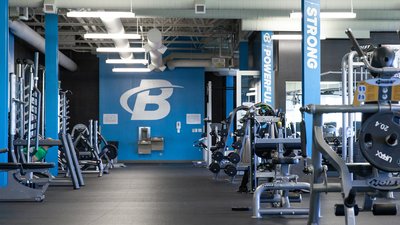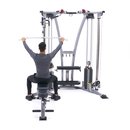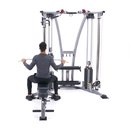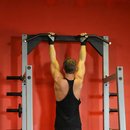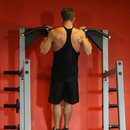The Question:
What are the best exercises for building lat width? Be descriptive (how many sets and reps, etc.).
What IFBB Pro has the freakiest lats? The smallest lats?
Do genetics play a role in lat development?
What body parts will help make the lat pose appear even more pronounced?
Bonus Question: What is the proper way to perform a front lat spread? Back lat spread?
Show off your knowledge to the world!
The Winners:
- sword chucks View Profile
Prizes: 1st place - 75 in store credit.
1st Place - sword chucks
Mastering the Physique - Training the Lats
Let's talk about training! Training for bodybuilders isn't the same for every muscle group, so we need to learn more than just exercises for training each muscle - each muscle should have a different way of being trained so that you grow as fast as possible and build a developed physique! Training the lats is something that, for some of us, is especially unique.
First I'm going to go into what exercises are best for widening the back. I will also throw in the distinction between width and thickness movements. You can read about the lat development that you can find in the IFBB Professional bodybuilding circle, and genetics in lat building. Finally, I will talk about how to get that V-Taper look by manipulating the physique, and touch on posing.
Back Training's Bread & Butter: Exercises
The best exercises for lat width are movements that work on a vertical plane, usually. There are also some exercises that work on a horizontal plane that are effective for width, too. Horizontal movements such as rows generally feed the back's thickness while vertical movements such as chins cause width to improve in the lats. There are also one or two movements that work somewhere in-between being strictly vertical or strictly horizontal pulling.
Chins & Pull-Ups:
The first movement that comes to mind for building the lats is chin-ups or pull-ups (both are pretty much the same). Advanced bodybuilders will be able to perform these with ease and are probably used to using extra weight on a dip belt or with a dumbbell between the feet when performing chins.
Intermediate bodybuilders are probably good for ten to twelve solid pull-ups and will sometimes be able to add weight.
Bodybuilders who are just starting will have a very hard time with the pull-ups, because it is just your entire bodyweight being moved by your arms and back, and you probably aren't strong enough to really perform well at pull-ups yet.
No matter who is performing them though, chins are a great lat builder. Advanced bodybuilders have many ways to go with chins. Since your body weight alone is so easy to do chins and pull-ups with, you can manipulate your grip and see which style of chins and pull-ups you like best.
There are several handles for chins and pull-ups. You can try using the V-bar handle by hanging it over the pullup bar like you might see in a long bar row, which I will talk about later.
You can use very wide grips, do partial reps at the bottom or top of the movement to really pump up the lats, and maybe even go for a one-armed chin or pull-up and build each side of the back individually.
You can also get the most out of chins because your back is so strong that you can pull your sternum up to the bar and manipulate time-under-tension like that.
Warmups Or Mass-building:
Once you find a style of chins and pull-ups that you prefer over the others, you can do one of two things - use that exercise as a warm-up for the back and biceps and use 3-4 sets of 8 reps to get the blood pumping, or treat it as a real mass-building movement and put a dumbbell between the ankles and work heavy in the 4-8 rep range after a warm-up. Advanced bodybuilders definitely have a lot of options for chins, because they can treat them like any other exercise.
Intermediate bodybuilders will have more trouble with chins, though. At an intermediate level, you will probably work with your bodyweight or adding five to twenty-five pounds of extra weight on very heavy sets. You are really limited to regular pull-ups or chins, because those two basic movements are hard enough for you.
You could try changing it up with variations in grip width and using different bars for the movement, but it would be best to just stick with regular pull-ups and chins. You will need to work on the pulldown machine to perform a thorough warm-up without tiring yourself out, and then you can do this movement early in the workout, adding weight if necessary to stay in the 4-8 rep range.
Most intermediate bodybuilders will probably have trouble doing these properly AFTER many other exercises, so fit them in early in the workout, and stick to the basics - A, B and C.
Beginning bodybuilders are the lifters that will be lucky to get 3 chins on a good day. This can be due to a lack of strength, or maybe you are carrying some extra body fat around that you shouldn't be. Either way, these are some things that will be sorted out quickly if you are consistent with lifting, and you can become a great chinner.
Until then, there are two substitutes for pull-ups that are pretty much the same movement.
First, you can perform pull-ups on a weight-assistance machine, and try to lower the amount of assistance each time you work out - this is great because it will allow you to stay in your desired rep range even when working with your entire bodyweight would be too much.
You can also do negatives on chins and pull-ups without actually doing the positive part, as the negative phase of an exercise is known to be up to 150% stronger than the muscles on the positive phase of it.
This is a very basic way to get the most out of pull-ups and chins, but remember not to overdo it- training at a level that is 150% harder than normal training isn't something you want to do too much, or you can get hurt.
For anybody that can perform chin-ups, pull-ups and any variation of those movements properly, I recommend them for many different rep ranges. Doing chins with a very heavy weight and strengthening the back with the 2-3 rep range is very effective, as chins are a basic and simple movement, and for some people training like this is the only way to perform real chins!
Chins in the 5-8 rep range are pretty typical for bodybuilders, whether they add weight or not. Any variation of pull-ups is also good for a warm-up movement if you are strong enough to easily pump out 8 to 10 chins for 3 sets without getting tired at all, like Lee Haney does.
On the other hand, if you can do that many you can also treat this movement as an exercise to bring up muscle endurance and conditioning - perform one to three sets of max reps with 30 to 60 seconds rest to get this effect from chins and pull-ups.
Cable Pulldowns:
Cable pulldowns are another lat exercise that is a vertical movement. Cable pulldowns are great for any bodybuilder at advanced or novice levels, actually, because anybody can manipulate the weight to be exactly what they need, unlike pull-ups and chins where you can only go as low as your bodyweight for weights.
The first variation to this is in grip. You can go wide-grip or close-grip for cable pulldowns. Most people prefer a wide grip because they think that wide grip means wide lats, but this isn't always so. A very wide grip does stretch the shoulder girdle out significantly, which widens the shoulders, but a very close grip blasts the outer lats and stretches the actual muscle like nothing else.
A very wide grip might be damaging to the shoulders of beginning bodybuilders who aren't used to the movement, too, or advanced bodybuilders who get aches and pains from the heavy weight. A medium grip on the lat pulldown is great for overall back mass, too.
There are several handles that you might come across in the gym, too, and all of them are good for variation in the routine. You are going to want to find a pulldown handle that gives you the best mind-to-muscle connection, and which,"Makes one rep equal two reps." -Lee Haney
For me, this is the widest cable bar in the gym, it is about 4 and a half feet long. I grip it just before the bar starts to curve and what I do is actually a bit weird to explain - I take the bar and twist it so that the curved ends are pointing up to the ceiling rather than at the floor - this angle seems to bring the lats even more into the motion. I also like the wide-grip neutral hand position bar, which I call an "I-bar".
Which way should the palms face when doing pulldowns? Well, since you can pick as low of a weight as necessary on pulldowns, do that, and try out EVERYTHING. When I was experimenting with the mind-to-muscle connection on various pulldown grips, I would use 50% of my 6-8 rep max at the time.
I tried close and wide reverse-grip pulldowns and the same grips for regular-grip pulldowns. I also tried out the special handles in the gym like "V-bars", "I-bars" and "M-bars". What worked best for me was the wide grip, palms-away style, although I can see some people with higher lats getting more out of the M-bar due to the neutral grip.
Pulldowns are great because you can go places with pulldowns that you couldn't go with regular pull-ups. I never would recommend training in the 2-3 rep range on the lat pulldown machine, or even going below five reps really. When I go with too many reps on this exercise, though, I just start to tire out easily and my back and arms become fatigued, but not worked hard. I stick in the middle - six to nine reps per set for me is about ideal.
Barbell Rows & Dumbbell Rows:
Barbell rows and dumbbell rows are some very basic back exercises that are necessary if your routine is made up of just A-B-C, basic movements. Rows with a barbell really effect the middle back and trapezius while single-arm rows hit more outer and lower lats from my experience.
Each exercise has some advantages over the other, so you should see which type of free-weight row, barbell or dumbbell, fits your needs best.
Barbell rows are more of a power movement for me. I love the feeling the day after a few perfect sets of bent-over barbell rows, just me pulling a heavy barbell to my chest all the way from the floor. The way I perform rows takes some getting used to for other people.
First, I usually warm-up pretty thoroughly when doing barbell rows. Barbell rows are unlike the above mentioned back movements because they require more stability from the hamstrings and lower back, and also pull more traps into the movement, so you should make sure those muscles are warm before performing bent over barbell rows. If you use perfect form, you can even create some new hamstring growth - a two in one effect.
First, I load a barbell up with weights and leave it on the floor, not in a power cage. I find no trouble in using forty-fives on each side, I can still get a full stretch in my back without the plates hitting the floor and stopping my movement. If you have long arms then try to use smaller plates though, as I want you PARALLEL with the ground.
I take a shoulder-width grip and pull to my lower chest, keeping my elbows in. I rarely go over one forty-five on each side and sometimes a ten too, but really I just keep perfect form, and as I gain weight, I am sure my strength will go up. Whatever you do, don't round your back! You could get an injury easily.
Do dumbbell rows in the same angle to the ground as you would barbell rows. Dumbbell rows will give a different feel though as they isolate more the back and take the lower back and hamstrings out of the movement somewhat. I really like dumbbell rows because I can just focus on training my back without fatiguing my lower back and I can also get more of a squeeze in my lats this way.
I used to go very heavy on these in my early stages of training, doing a "starting-the-lawnmower" type of motion to compensate for the huge poundage, but now I make sure to only contract the back and not twist or raise my shoulders more than necessary.
I also realized that jerking the weight when performing single-armed rows is very easy and there are a few ways that you might be doing it and you won't even notice- so I always perform very slow reps.
Free-weight rows are both great for back development and thickness. Here is how I would use them as far as reps go. For barbell rows, I like to use them as a power movement if I need one rather than dumbbell rows, so they are good for the 2 to 5 rep range. However, I usually stick to 5 to 8 reps on barbell rows.
I never go too high because you'll find that this exercise will really make your lungs tired before your back! For dumbbell rows, I think you can go higher reps and do more sets of twelve reps or higher if you want to, as you don't have to worry about lungs or posterior chain failing before the back.
I would not use this as a power movement but you can train it in the 5 to 8 rep range too. For barbell rows, I usually will perform 3 to 5 sets. For dumbbell rows, I also perform 3 to 5 sets, but make sure that you do the same number of sets and repetitions for each arm, or you could create an unbalance in strength that you don't want!
Cable Rows:
Cable rows are different than barbell and dumbbell rows and I separated both variations of the row because cable rows work the back at an entirely different angle. From barbell and dumbbell rows you just can't get the isolation and the stretch that you get from cable rows.
Your gym probably has a specific apparatus just for cable rows, so it shouldn't be hard to find it. First, place your feet firmly on the foot pads, evenly spaced out. Then, firmly grasp the handle. When performing any exercise, you should start with a firm grip, even if you do end up just having the weight off the end of your fingers at the end of a set.
Do not have your knees too bent when performing this movement as it could limit your range of motion. Also, you will strengthen the hamstrings by going just short of locking out at the knees. Next, lean forward with the weight entirely, let the back stretch, then pull the weight to your lower stomach area.
I see too many people in the gym just performing partial reps on the cable row, and working more arms than back by simply pulling with the arms and not allowing the back to move. If you want to hit the back from multiple faucets, do not be rigid like this - instead, make sure to lean forward all the way, almost into a pulldown and then pull-up, leaning back to perpendicular with the seat and with the weight at your lower stomach simultaneously.
There are several different handles that you can try for seated cable rows. I think that it is important to find which one you like best and which gives the best mind-muscle connection to the back. For me, the V-bar cable attachment is awesome for cable rows, even if it doesn't hit my back very hard on lat pulldowns.
I think the reason that it is so effective is that it is a narrow grip, so it targets outer lats more. A wide grip bar might work well for you too, though, so try that out. Straight bars with a reverse grip or palms-down grips might also provide a new feeling in the back for you, so just try different things out.
Cable rows are really an isolation movement more than anything else. I would not use them for power training as barbell rows are much better for that. The 5 to 8 rep range is nice on these, but cable rows are also great because you can go to even higher rep ranges without worrying about the back giving out on you before your lats hit failure.
I also like cable rows because they are different than other row exercises so that you can manipulate time-under-tension such as lengthening the negative portion of the movement without letting it distract you from perfect form. I would perform three sets of eight to twelve repetitions on the seated cable row.
Putting It All Together
So if these are the bread and butter exercises for back training, what are some good ways to combine them all into one single intense day of training per week, or maybe even two? I am going to go into that in this section.
Basically, I always recommend starting with a movement like chins or pulldowns, placing lower rep movements first too. Then I might do my rows after the first vertical pull movement, or alternate between types of exercises. Here are some routine ideas below:

BodyFit
$6.99/month- 2,500+ expert-created single workouts
- 3,500+ how-to exercise videos
- Detailed workout instruction
- Step-by-step workout tips
- Training at gym or at home
- Access to Workout Plans
- Access to Bodyfit App
- Store Discounts
Already have a Bodybuilding.com account with BodyFit? Sign In

What comes with BodyFit?

- Instructional Videos
Don't risk doing a workout improperly! Avoid injury and keep your form in check with in-depth instructional videos.

- How-to Images
View our enormous library of workout photos and see exactly how each exercise should be done before you give it a shot.

- Step-by-Step Instructions
Quickly read through our step-by-step directions to ensure you're doing each workout correctly the first time, every time.

BodyFit
$6.99/month- 2,500+ expert-created single workouts
- 3,500+ how-to exercise videos
- Detailed workout instruction
- Step-by-step workout tips
- Training at gym or at home
- Access to Workout Plans
- Access to Bodyfit App
- Store Discounts
Already have a Bodybuilding.com account with BodyFit? Sign In

What comes with BodyFit?

- Instructional Videos
Don't risk doing a workout improperly! Avoid injury and keep your form in check with in-depth instructional videos.

- How-to Images
View our enormous library of workout photos and see exactly how each exercise should be done before you give it a shot.

- Step-by-Step Instructions
Quickly read through our step-by-step directions to ensure you're doing each workout correctly the first time, every time.

BodyFit
$6.99/month- 2,500+ expert-created single workouts
- 3,500+ how-to exercise videos
- Detailed workout instruction
- Step-by-step workout tips
- Training at gym or at home
- Access to Workout Plans
- Access to Bodyfit App
- Store Discounts
Already have a Bodybuilding.com account with BodyFit? Sign In

What comes with BodyFit?

- Instructional Videos
Don't risk doing a workout improperly! Avoid injury and keep your form in check with in-depth instructional videos.

- How-to Images
View our enormous library of workout photos and see exactly how each exercise should be done before you give it a shot.

- Step-by-Step Instructions
Quickly read through our step-by-step directions to ensure you're doing each workout correctly the first time, every time.
The Best Of The Best:
Best Lats In Bodybuilding.
In IFBB pro bodybuilding, EVERYBODY is HUGE. However, there are still some bodybuilders in this past Olympia who stand out due to a particular body part, such as the lats.
Ronnie Coleman's lats are just huge. He might not have an insane V-Taper, but that doesn't mean that his lats aren't big, it just means that his waistline makes them look smaller, an unfortunate illusion. Ronnie has one of the biggest and strongest backs of all time.
His DVD shows him performing repetitions on the barbell row with nearly five hundred pounds! His lats are giant and if his waist was as small as, say, Dexter Jackson's, he would have the best V-Taper in history! He would likely be 20 pounds lighter for competition weight if he didn't have those huge lats.
Mike Sheridan is a bodybuilder who is just working his way up the ranks in the Olympia. He doesn't seem like he has much in the way of lats right now, so that is something that he needs to work on.
Genetics:
Do Genetics Play A Role In Lat Development?
Genetics play a huge role in the development of every muscle. For lats, this role is no less. For example, some bodybuilders just won't develop sweeping lats like others and might have an extremely hard time building the back. However, the SHAPE of the lats is what really makes these genetically different, not simply lat size. Lats are a big muscle group, but their shape can vary quite a bit.
For most people, lats either have high bellies, low bellies, or somewhere in between. For people with high lat bellies, you might develop some decent width, but really your lats will look small from the front because they don't take up much space. For you, I would give this advice - use lots of close-grip pulldowns to stretch the muscle out and you might lengthen the lat bellies a bit. Single-arm cable rows also give a huge stretch which will make a difference in your lat placing.
People with extremely low lat bellies might look like they don't even have lats on the other hand. You guys with low lat bellies should still use a full range-of-motion for back training and train back like you regularly would, but keep your waist size from getting too large!
Otherwise you might hurt your physique by eliminating the V-Taper completely. People with medium lat bellies have it the best, though. Your lats will look big on your body and you don't need to focus on stretching them out more than you normally would.
What Are You:
How Do You Tell What Your Genetics Are For Lats?
Well, just hit a lat spread and you will be able to see where your back begins to pop out. If it pops out right near your hands, then you must have low lats, because your hands should be right on your waist. If your lats start just 4 or 5 inches below the armpits, then you have HIGH lats! If they are clearly somewhere in between then you have medium lat bellies.
Overall, you shouldn't let your lat genetics worry you too much, just build your physique up and enter your contest in great condition and you will know that you did your best!
Complimenting The Lats:
In lat spread poses, you might want your lats to stand out, but you don't want to have ONLY lat development! Posing is all about how the body comes together and looks as a whole.
Front Lat Spread:
For the front lat spread, the important muscles in order of importance, are side deltoids, the chest, the abdominals, the triceps and the quads. If you are posing the back, why isn't it the back that is important? Well, the front lat spread is really showing the front of your body - the "pushing" muscles.
Side Deltoids: The side deltoids are the most important because they will make you appear even MORE wide than your lats do if you have good side deltoid development. They can add a lot of mass just where the center of vision will be.
The Chest: The chest is also key here! You don't want your chest to disappear when performing a front lat pose. Your chest should be flexed actually.
The Triceps: The next most important muscle is the triceps. You might not consider this, but when you perform the pose right, they can have the same effect on the appearance of width as the side deltoids do. The triceps are key!
The Abs: The abs are also important, you don't want to show a flat stomach during the front lat spread!
The Quads: The quadriceps are also proudly displayed when you perform the front lat spread, and if you don't show off your quadriceps, you are missing out on possible points in the pose. Big quads will make you look wider!
Rear Lat Spread:
The rear lat spread is one that makes more sense as far as what muscles are important to you. You will need to worry about the muscles that are actually on the back, the "pull" muscles!
Rear Delts: The rear delts will have the same effect that the side delts do here. They will make you look wider, but you will also be able to see them in all of their development. So make sure to train your rear delts!
Traps: Traps will also show up in this pose, as they stretch down the entire back.
Calves: Calves will also be proudly displayed as your most noticeable leg muscle in this position, so make sure you have calves that look good flexed and pop out at the ankle.
Triceps: Triceps will also add to width in the rear lat pose, so make sure you have tris that just bulge out of the back of your arms, and all of your lat poses will be happy.
Showing Off Your Lats
Posing the lats really isn't easy to learn. However, I am going to explain it in this section so that you can work on it for a while each day until you get the hang of it! Just like getting that mind to muscle connection in the lats, this ability doesn't come immediately, but will come with practice.
To spread the lats, whether it is a front or rear lat pose, you must first put your chest out. Then, move your elbows forward and bring your elbows together in front of you. Do this slowly so that the lats "come with" your elbows, and what I mean by this is that they should be spreading as your arms spread.
Then, you will find that your traps are flexed. Well, let your shoulders down, and rotate your elbows forward a bit more - at this point your chest should be flexed. At this point, I usually put my thumb against the back of my waist to keep my fists from pointing forward. My knuckles are usually facing each other while they are holding my waist.
Make sure that you're not leaning forward too far or back too far. Practice this in the mirror to see what angle makes your lats appear largest.
While you should spread your lats in the same way for both front and rear lat spreads, you should also be sure to flex certain muscles depending on what pose you are performing.
Front Lat Spread:
- Lace one foot forward, with both toes facing forward, and your quadriceps flexed.
- Spread the lats as I described above.
- Make sure that the chest is tensed.
- Make sure that your deltoids are tensed.
- Smile and look proud!
Rear Lat Spread:
- Place one foot behind you on the toes, and flex the calve on that ankle.
- Make sure not to lean too far forward.
- Spread the lats as I described above.
- Flex the hamstrings and glutes.
- Don't let your confident facial expression down, somebody might see you from the side too!
Posing the lats is key in competition. If a bodybuilder can't properly show the lats, it doesn't matter how big they are, they probably will not win the competition. Make sure nobody has this advantage over you!
Conclusion
This article should have helped you perfect your execution in each back movement, think of how to put together a back routine, and to learn how to showcase the lats in competition.
While you are doing all of these training routines, remember the basic principles for mass gains - if you place a heavy stimulus on the body after letting it recover for an extended period of time, a growth response WILL take place. Your diet is still key just as building any muscle mass too.
Make sure that you have everything in check with your lifestyle, and then use this training knowledge to improve your results a bit more.


